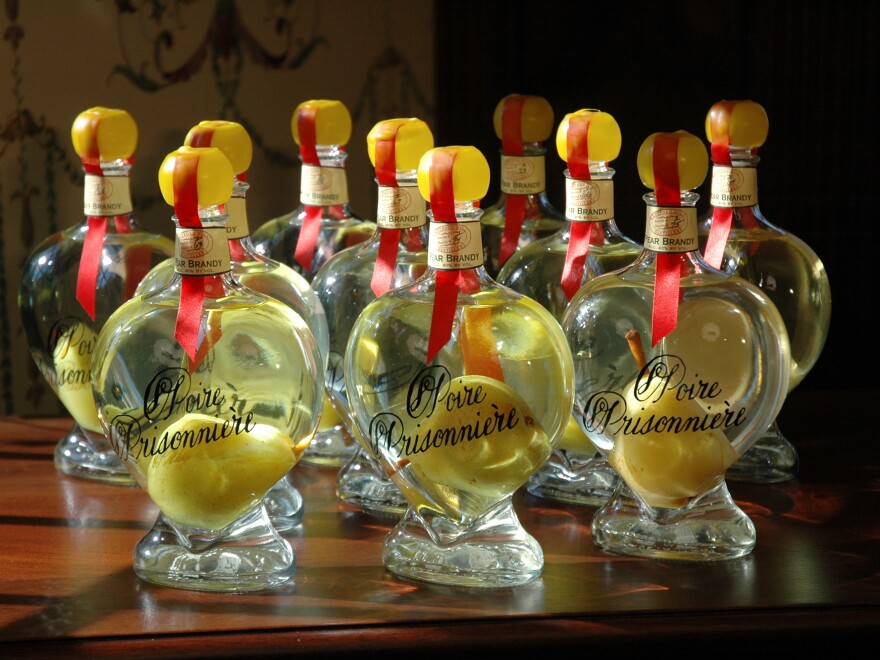Every springtime in the lovely Alsace region of France, people stand in blossoming pear orchards, sliding glass bottles over tender young pears. The workers fasten the bottles securely to nearby branches, and then wait a few months for each tiny pear to grow and ripen in its own little glass greenhouse.
In late summer, they remove the bottles and pluck off leaves, clean the pear and glass, and finally, pour in colorless pear brandy — distilled from last year's harvest. Once they seal it up, voila, they've made a beautiful bottle of brandy with a whole pear inside. This is the astonishing, age-old tradition first invented in Alsace in the 1700s and known as eau de vie de poire, or pear water of life.
Lately, pear-in-the bottle brandy has made a comeback in America — a kind of artful flourish from the fast-growing sector of locavore, craft brandies. In keeping with the farm-to-table movement, dozens of distilleries in the U.S. are now crafting dry, fragrant spirits from other mashed and fermented fruits, too — like cherries, pears, plums, raspberries, apples and peaches — sourced from local orchards. (Unlike pear, those brandies don't have whole fruit inside the bottle, at least in the U.S.)

To make eau de vie, mashed fruit pulp is fermented and distilled. It takes two weeks to ferment the mash with wine yeast and turn the sugars in the fruits into alcohol. Then they load the still with the fermented mash.
After it distills down, it rests from six months to a year in stainless steel or glass, with one exception: apple eau de vie, which is sometimes aged in oak barrels, giving it a darker hue. As it rests, the brandy develops character and aromas. Just before it's bottled, it is typically cut with spring water.
As for the pear version, over several years, the pear releases sugars into the brandy, giving it a sherried quality, while the fruit absorbs the alcohol. To eat the brandy-soaked pear, the bottle must be carefully broken, and the pear thoroughly washed to be sure there are no glass fragments. At 80 proof, these brandies are most commonly served as an after dinner digestif — in shot glasses — or used in cooking to add aromatic fruity scents to marinades and sauces.
Brandy, though, has long been a clever way of preserving excess fruit that would otherwise rot. And pure fruit brandies were actually popular in colonial America. At that time, over 1,800 fruit brandy distilleries dotted the Antebellum south.
But Prohibition, and then the spread of relatively cheap, grain-based spirits, put an end to that era. The art was mostly lost in America until 1982, when a German named Jörg Rupf founded California's , the first American craft distillery since the Prohibition. The fruit brandies he began making there inspired the American artisan distillation movement.
Soon dozens of distilleries were making fragrant, fruit-based eaux-de-vie. Local orchards welcomed the business, because distillers paid well for their fruit, turning cents on the pear or apple into expensive dollars in the bottle.

"It's a great way to support our orchards," says Don Coe of in Suttons Bay, Mich., a winery, distillery and inn that has been producing wines and fruit brandies since 1999. Coe, for instance, buys pears from a nearby orchard for 20 cents a pound that previously only got 10 cents a pound for pears. Coe also pays the orchard $10 per pear in a bottle. Even then, it's quite lucrative for him. Says Coe: "Essentially we're turning what was once a 3-cent pear into a $60 bottle of brandy."
Daniel Ruiz, head distiller at in Portland, Ore., agrees. Clear Creek sources blue plums and cherries from nearby orchards, and buys half a million pounds of Bartlett pears to make 2,000 cases of pear brandy each year. "Bartletts are the ideal pear to distill because of the balance of sugars and aromatics," says Ruiz. "The Bartlett has a unique aroma that carries all the way through to the finished spirit."
Often, distilleries buy "gradeouts"— essentially fruit seconds that are too small, too large or otherwise blemished. (Some people might call these the "ugly" fruits.)
"We purchase 100,000 pounds of fruit a year," says Louis Chatey, cofounder with his wife Margaret, of in Ashford, Conn. "These fruit seconds can be difficult for orchards to market otherwise, because they don't appeal to the supermarket shopper."
Westford Hill's pear-in-the-bottle eau de vie is dubbed Poire Prisonniere (imprisoned pear), and sold in a heart-shaped bottle. (The bottle nabbed a Best of Show in Package Design at Los Angeles International Wine & Spirits Competition in 2008.) "This glass is designed and produced in Italy," says Margaret Chatey, "and we feel the bottle's shape echoes the lovely curves of the pear."
"Making fruit brandies has all the typical challenges of agriculture," says Louis Chatey, "and all the wonderful romance of winemaking and distilling. When we started Westford Hills 16 years ago there were six craft distilleries in the nation. Now there are over 500, and a few dozen specialize in brandies and eau de vie."
It's truly the spirit of an orchard in a bottle.
Recipe: Clear Creek Distillery's Pear Brandy Sidecar
1 ½ ounce Clear Creek Pear Brandy
¾ ounce Cointreau
¾ ounce fresh squeezed lemon juice
Shake all ingredients in a shaker, and double strain into a chilled martini glass.
Jill Neimark is an Atlanta-based writer whose work has been featured in Discover, Scientific American, Science, Nautilus, Aeon, Psychology Today and The New York Times.
Copyright 2020 NPR. To see more, visit https://www.npr.org.



